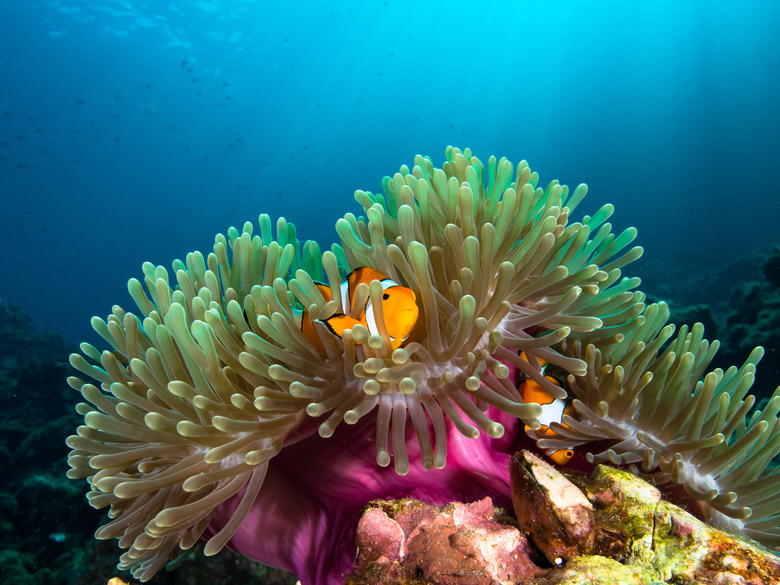Physical Characteristics Of A Sea Anemone
Predatory sea anemones — scientific name Actinariums, part of the phylum Cnidaria — are found in all of the world's oceans and seas. Related to jellyfish, sea anemones can deliver a painful sting to people and other animals unlucky enough to come into contact with one. These creatures adhere to rocks and do not move very often.
Size
Size
Sea anemones can vary in size, depending on the species in question as well as the location of the anemone. At their smallest, sea anemones can be around the size of a pinhead. The biggest sea anemones found to date are 3 feet in diameter. The largest varieties are Stoichatis and Discoma; the biggest anemones tend to be found in warmer, tropical waters rather than in harsh, cold climates.
Composition
Composition
Sea anemones have a soft, simple polyp-style body with two tissue layers and a central gut cavity. The anemone's "mouth" leads to its gut. The "mouth" of the anemone is surrounded by stinging tentacles which are used to disarm food — such as plankton and small animals — and to disable enemies. Anemones, related to corals, do not share corals' hard exoskeleton structure.
Weight
Weight
The largest sea anemones — the ones found in tropical waters that can have mouths up to 2 feet across — can weigh as much as 440 lbs. On the other end of the spectrum, tiny quarter-inch anemones can weigh almost nothing. Small inch-wide anemones weigh around 40 g, or .022 lbs.
Colors
Colors
The most colorful species of anemones are found in warm waters, where anemones tend to thrive. At these warmer temperatures, scientists have discovered anemones of all colors of the rainbow. Some of these anemones are fluorescent shades of orange, purple, pink and green. In colder waters that are more difficult for sea anemones, the anemones tend to be duller, dimmer colors; browns and grays are the usual colors of anemones in the West Coast's Pacific Ocean, for example.
Cite This Article
MLA
Yapp, Ginger. "Physical Characteristics Of A Sea Anemone" sciencing.com, https://www.sciencing.com/physical-characteristics-sea-anemone-8680735/. 22 November 2019.
APA
Yapp, Ginger. (2019, November 22). Physical Characteristics Of A Sea Anemone. sciencing.com. Retrieved from https://www.sciencing.com/physical-characteristics-sea-anemone-8680735/
Chicago
Yapp, Ginger. Physical Characteristics Of A Sea Anemone last modified March 24, 2022. https://www.sciencing.com/physical-characteristics-sea-anemone-8680735/
